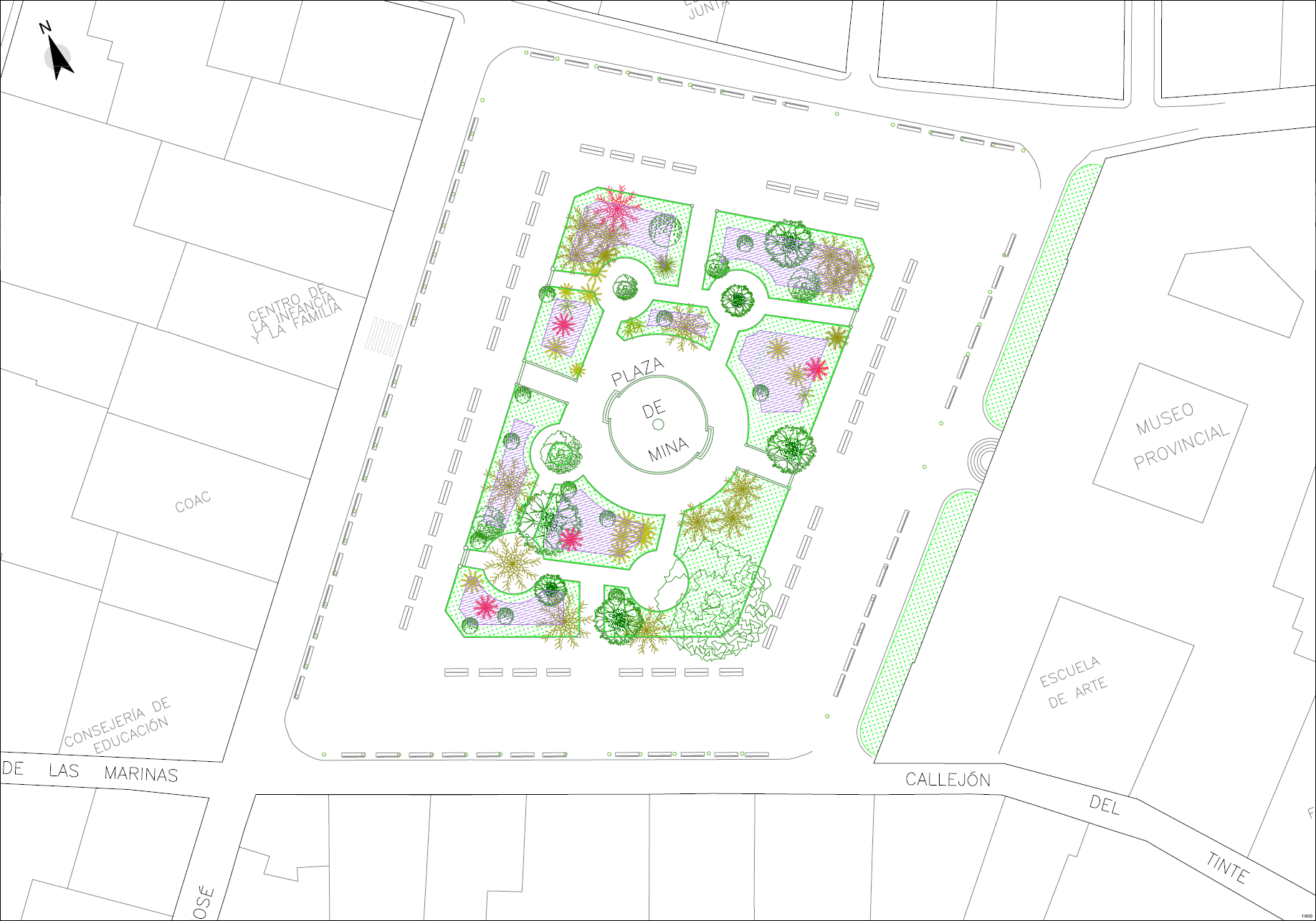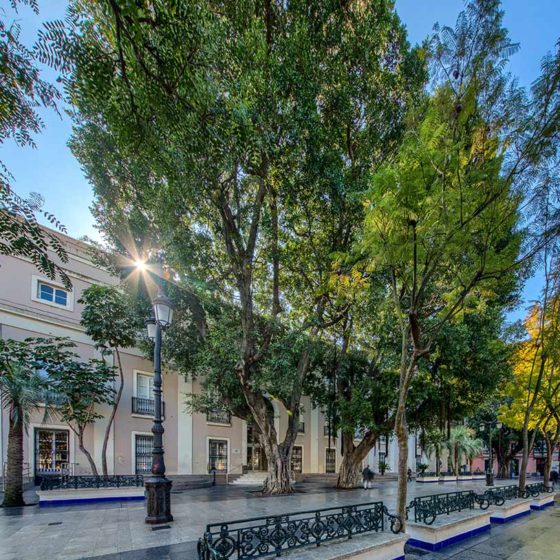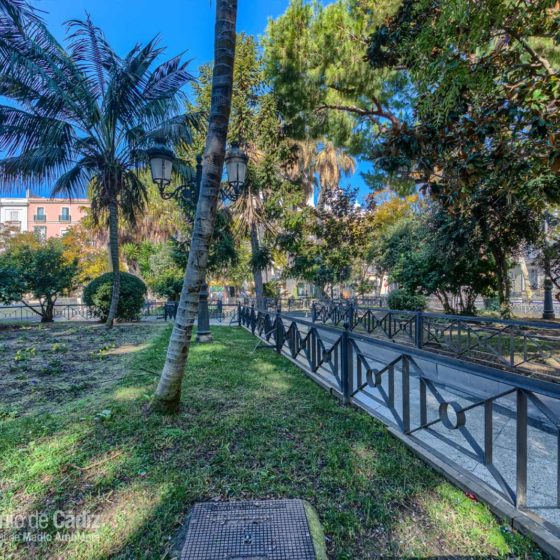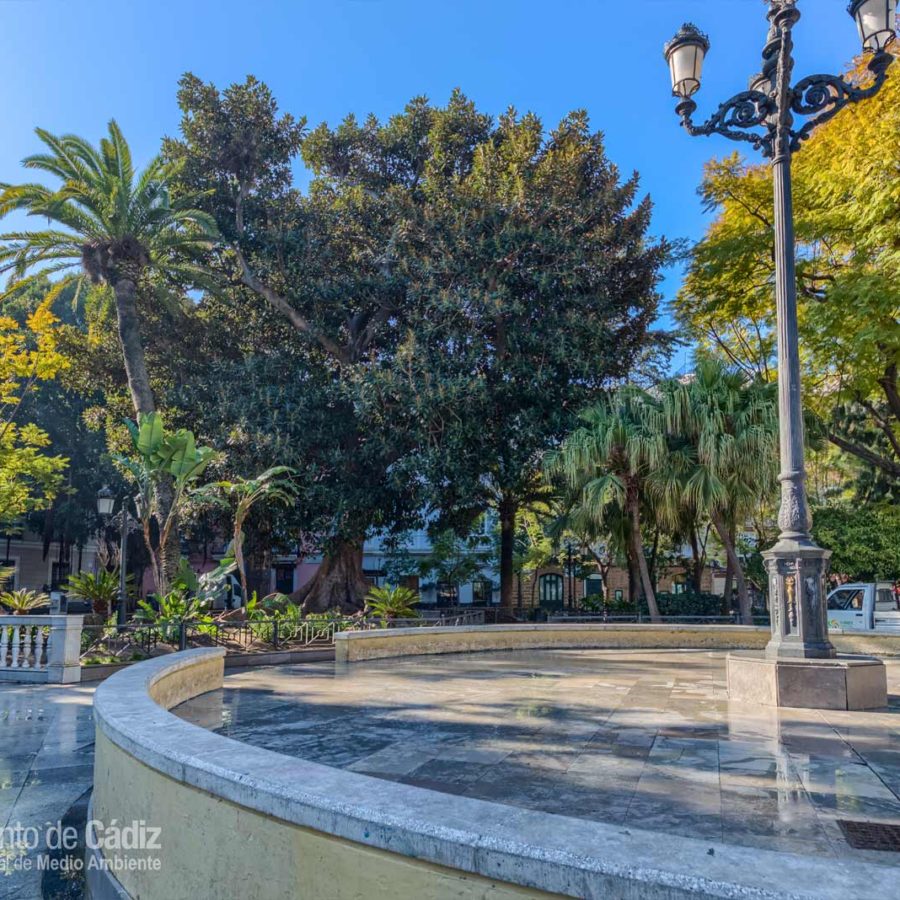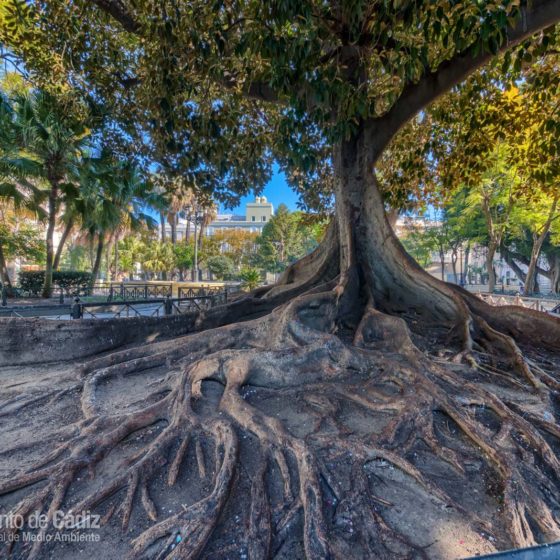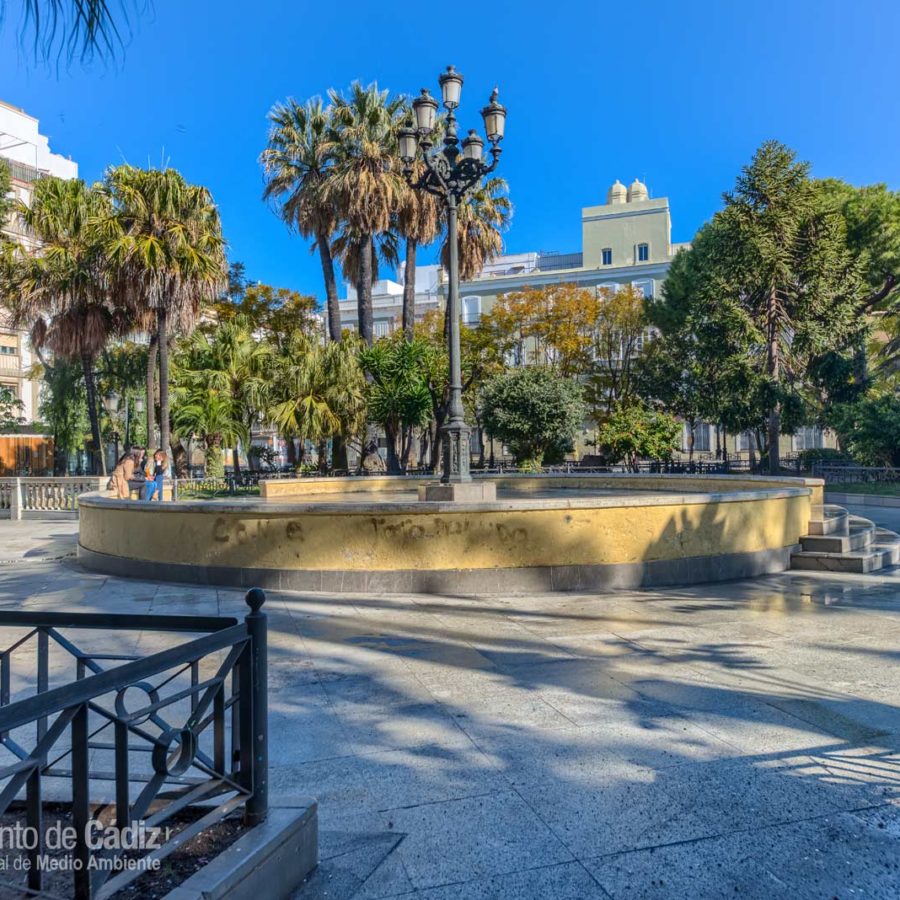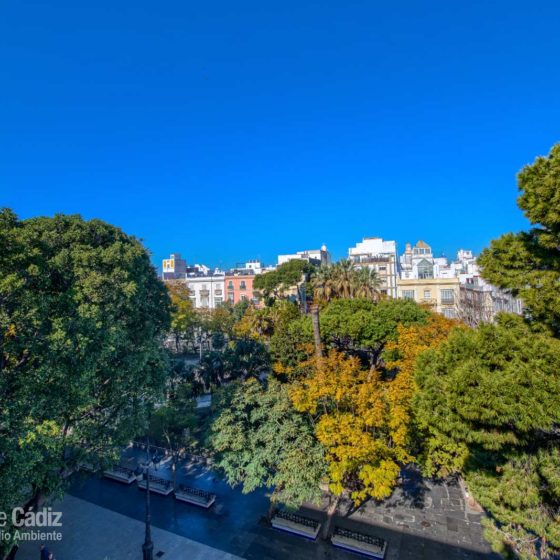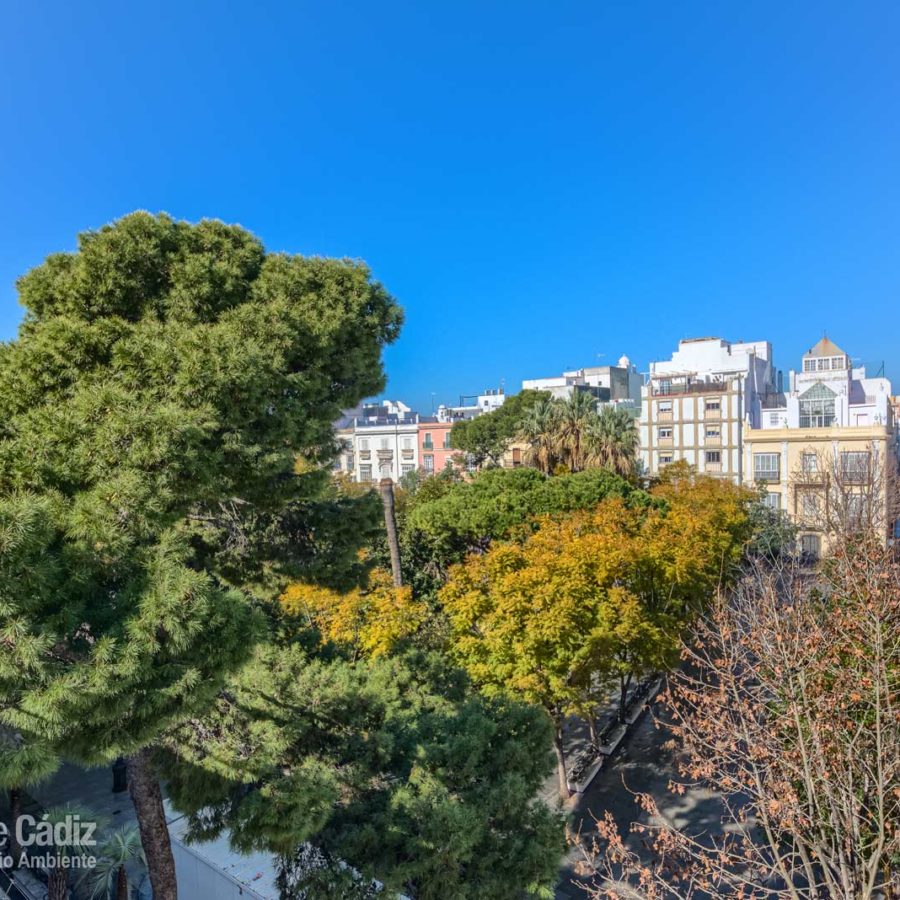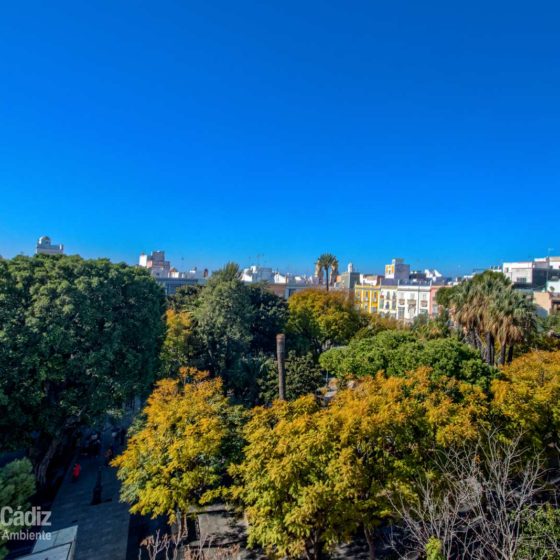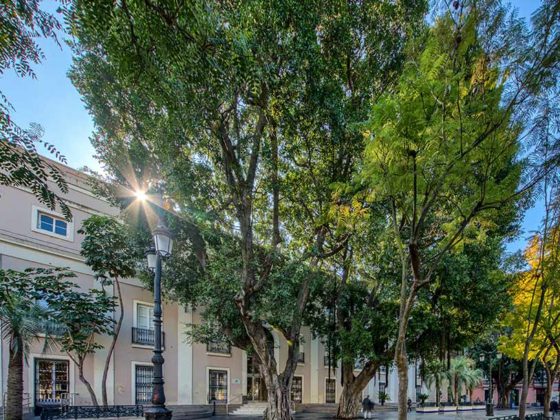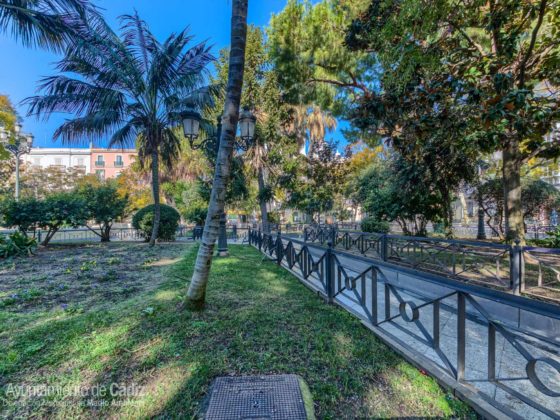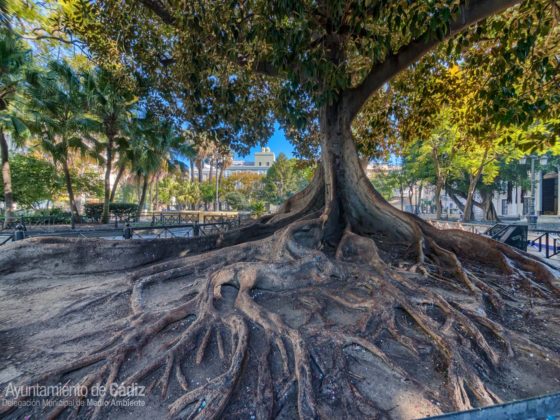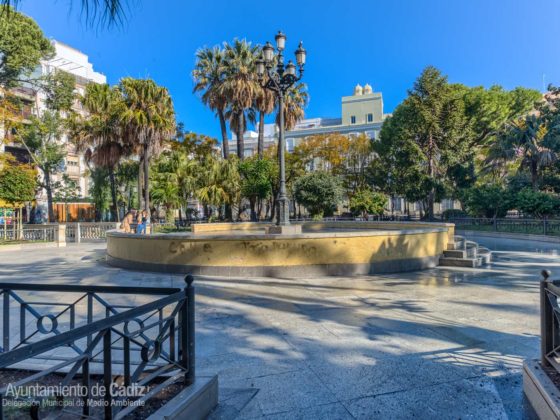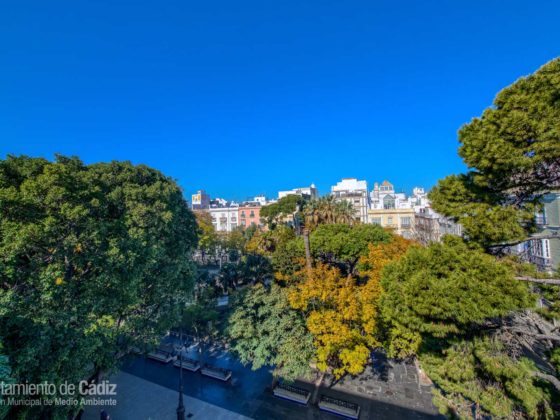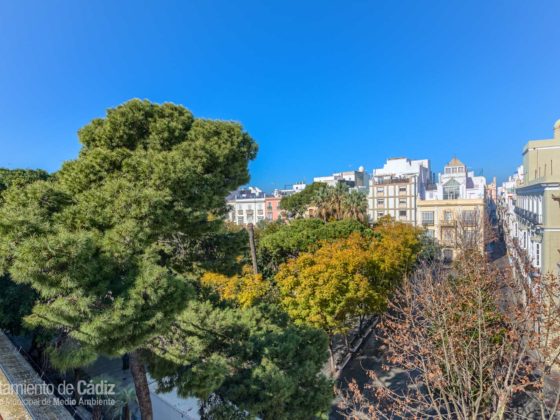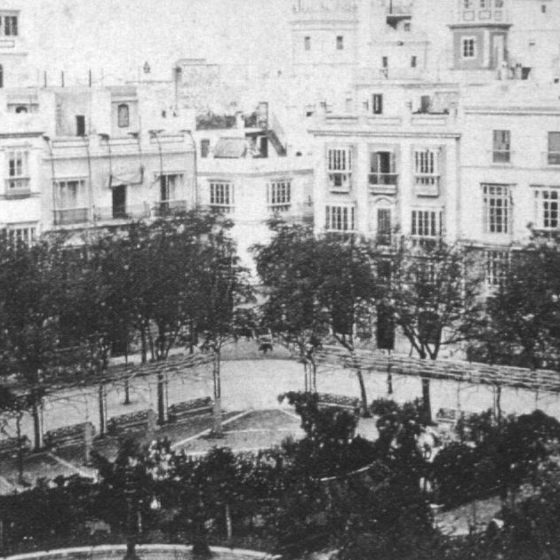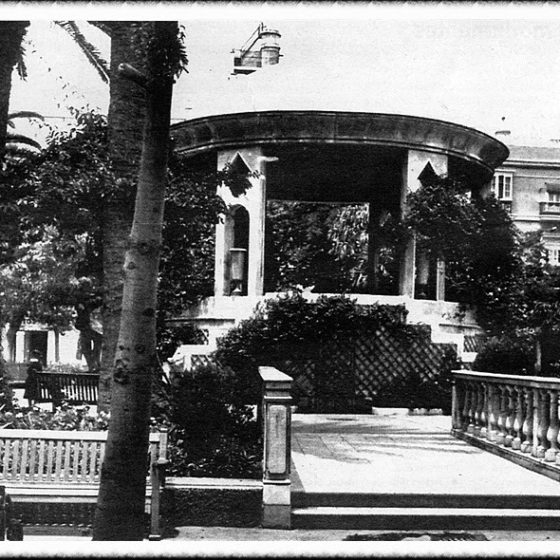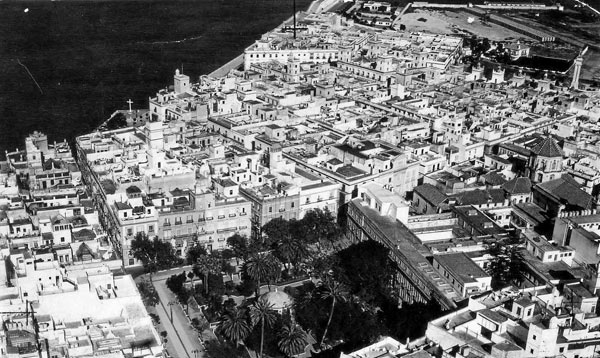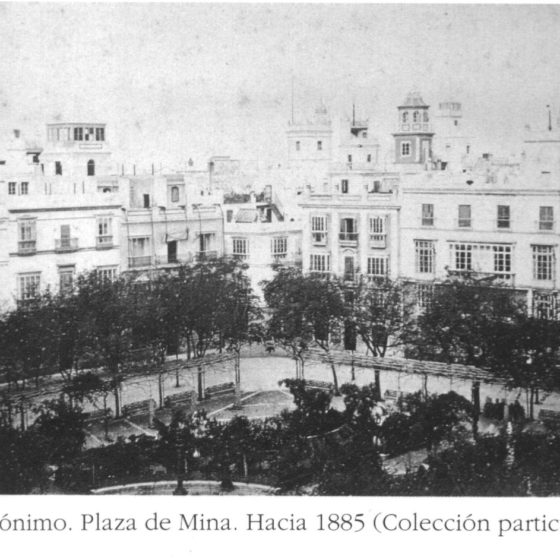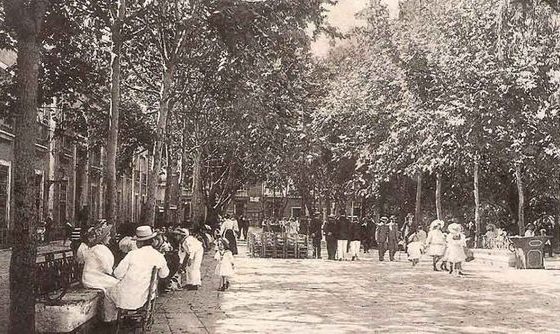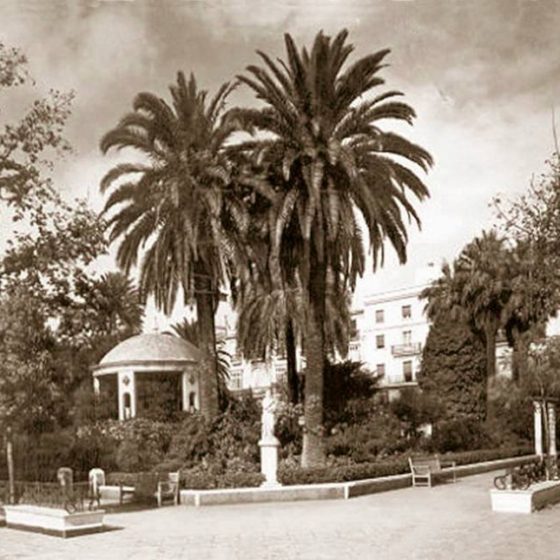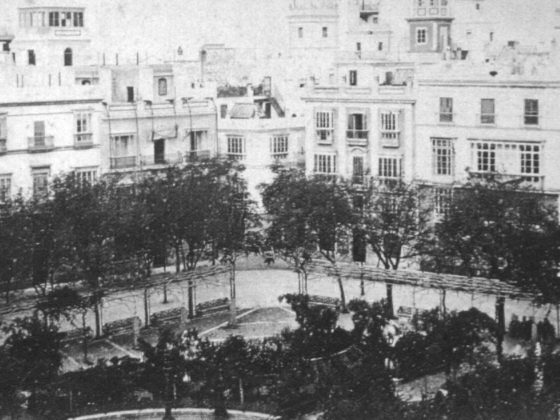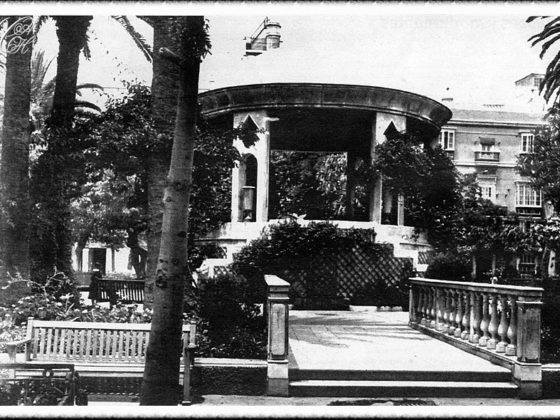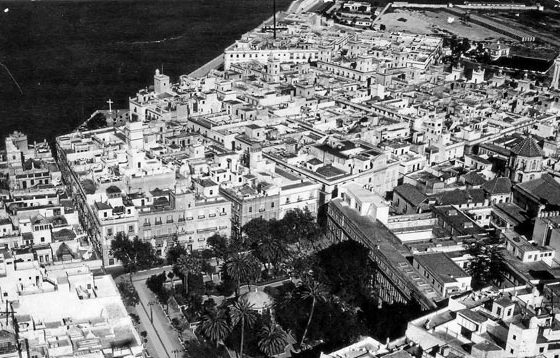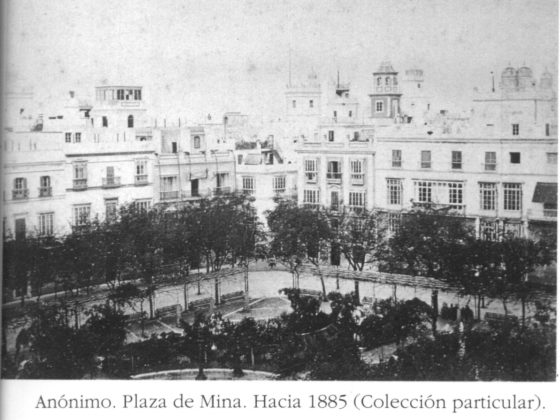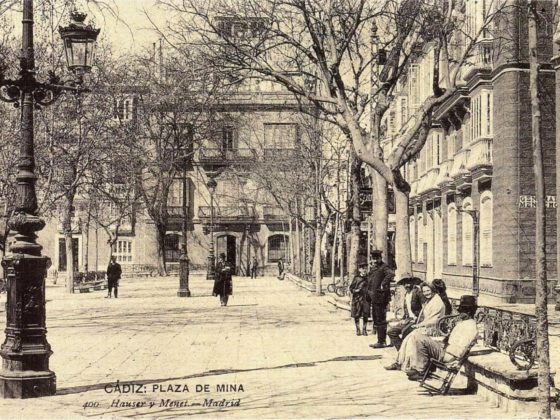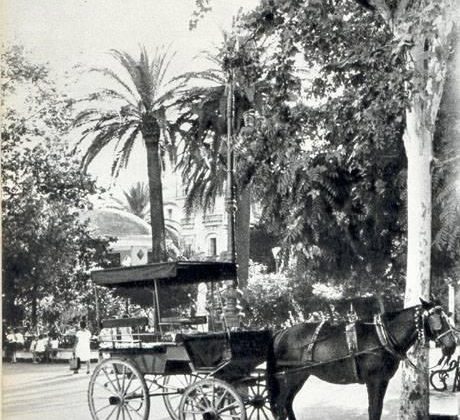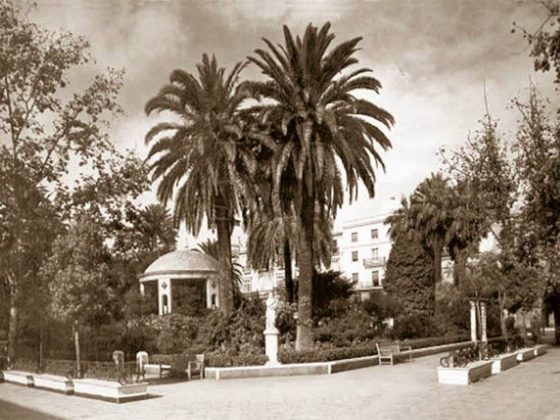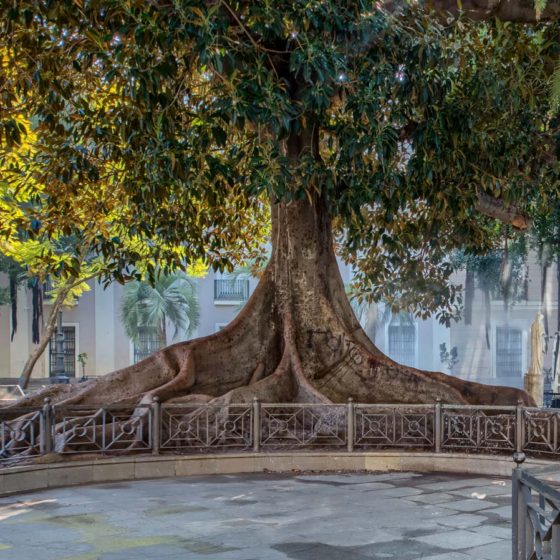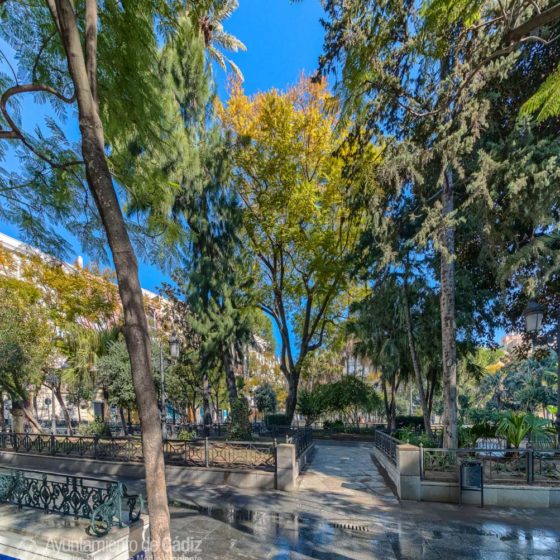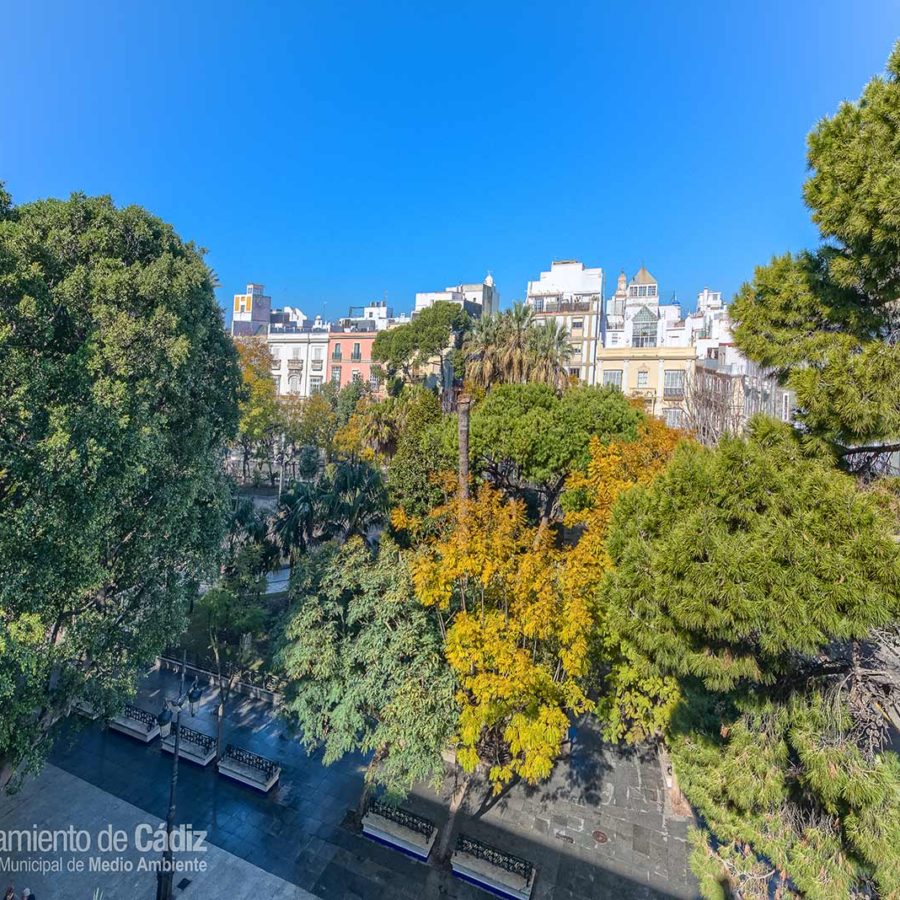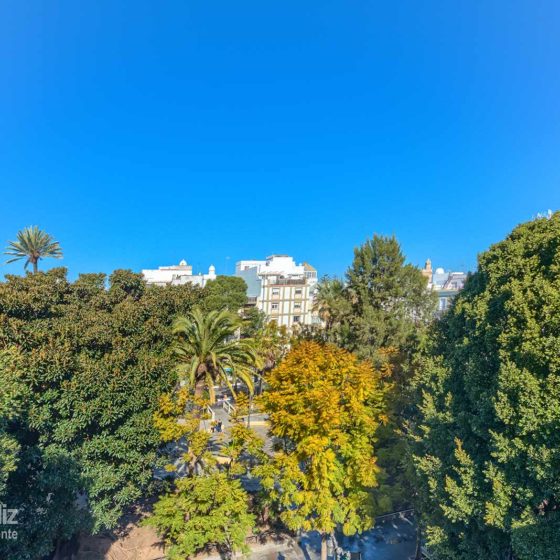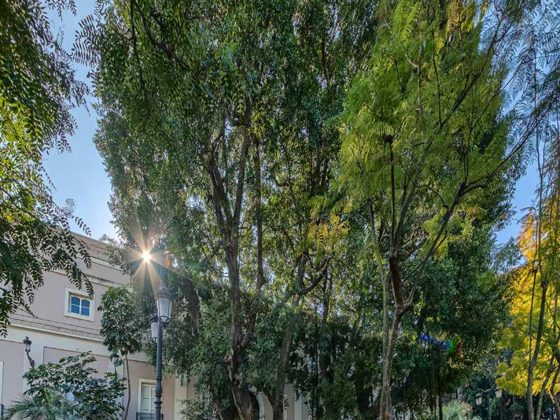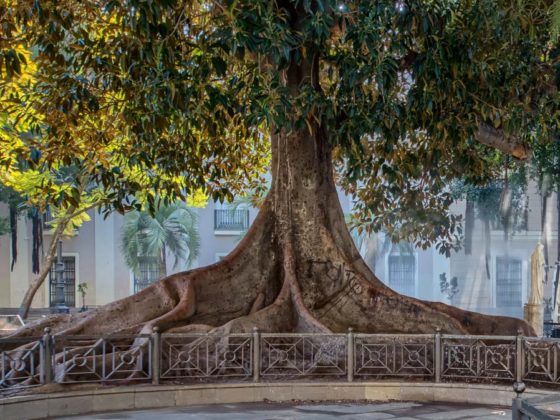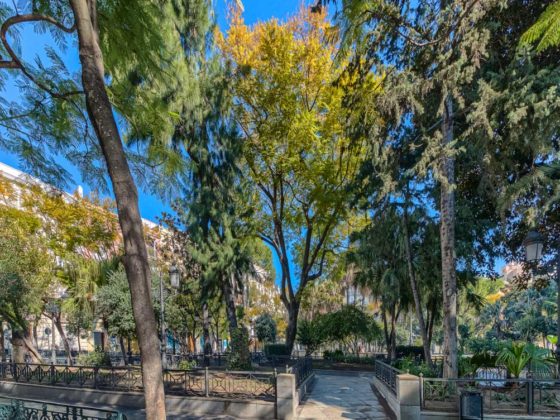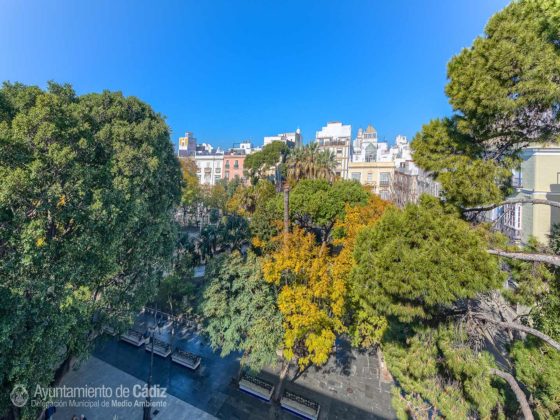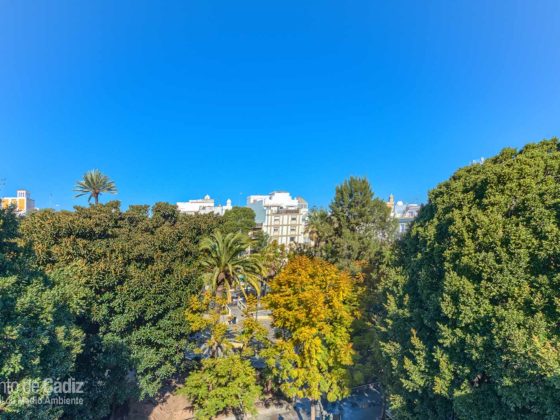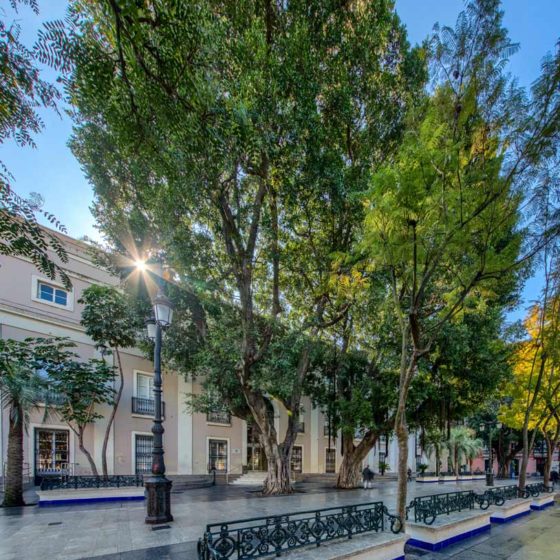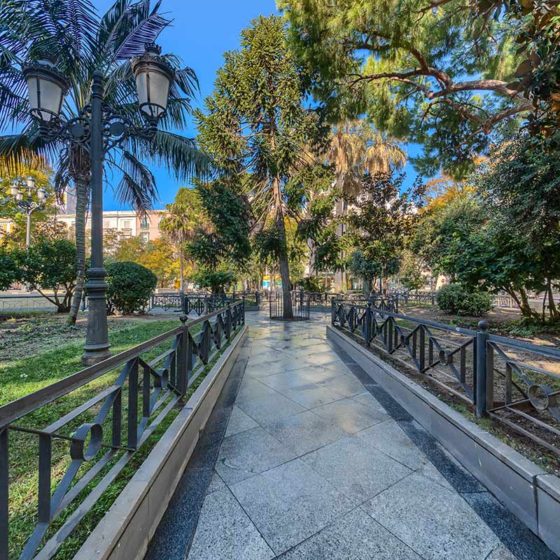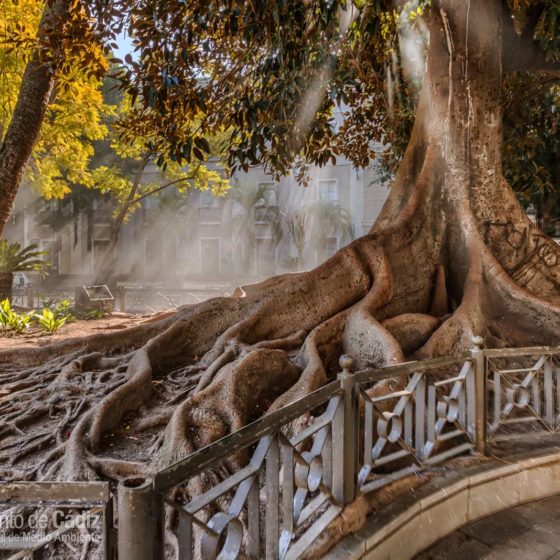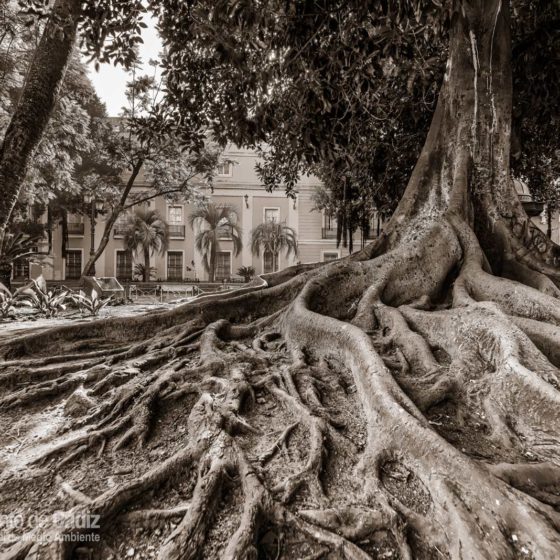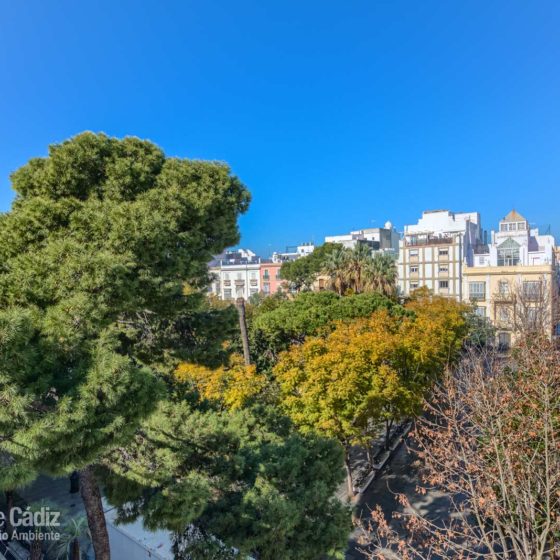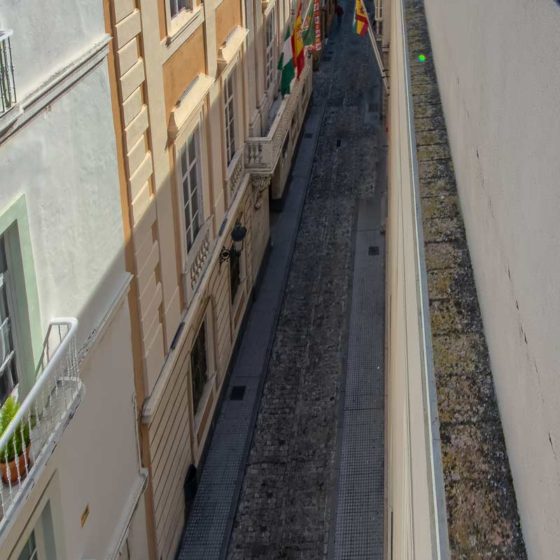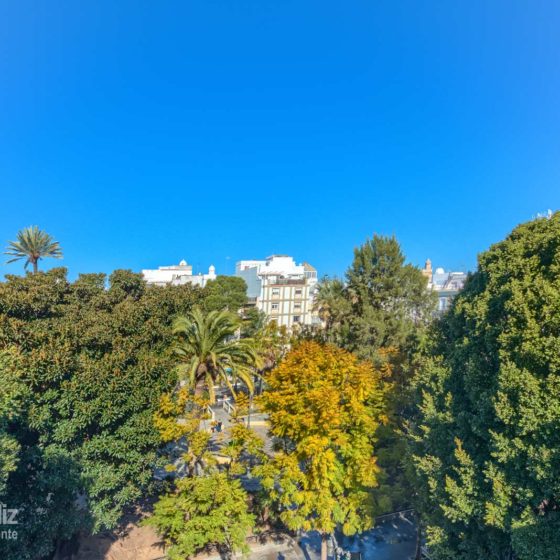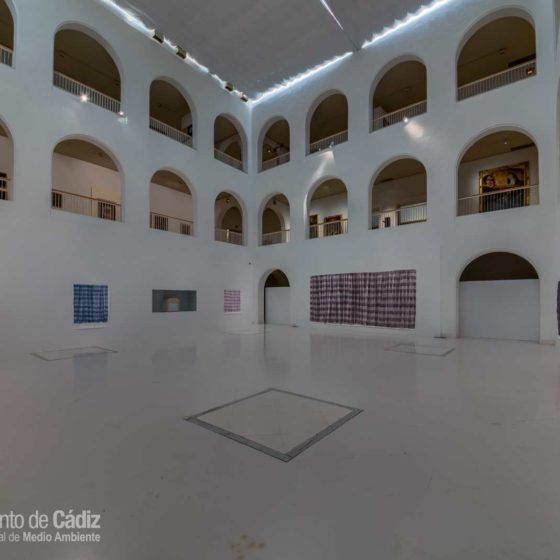Located on the land formerly occupied by the garden and the infirmary of the Convent of Saint Francis
With its nineteenth-century aesthetics, this square dates back to 1838. It owes its name to the statue of Sir Francisco Espoz y Mina, a hero of the War of Independence and who later fought against King Fernando VII at the head of the Liberal Army, which for a long time, occupied the central circle of the Square.
The Square
History
Botanical Species
The Square
Mina Square is one of the most emblematic squares of the city and the most crowded with people of all ages from Cadiz, witnessing the history of the city over the last two centuries.
Its shape is quadrangular and it is designed around a central roundabout, from which radial roads diverge which link to a wide perimeter walkway, edged by trees and benches with forged backs, central cast iron streetlights, and a central zone divided into asymmetrical flowerbeds. These flowerbeds are separated from each other by walkways which in some cases are bounded by marble railings and squares, leaving a circle in the centre, which was initially occupied by the statue of Sir Francisco Espoz y Mina .For some time, he occupied a bandstand where concerts were given. This same bandstand was demolished during its last remodelling in 1991 and was replaced by a large metal lamppost.
The square on its outer perimeter is made up of four arrangements of different species .Among those that stand out, for their size and uniqueness, are several specimens of Aleppo pine (Pinus halepensis) which are approximately 100 years old, and different specimens of the Illawarra flame tree (Brachychiton acerifolius), The London Plane (Platanus hybrida), The tree of Heaven (Ailanthus altíssima) or The Bottle tree (Brachychiton populneus). Likewise, the existing specimens of The Royal poinciana (Delonix regia) stand out for their great beauty when in flower.
In the front of the Provincial Museum, there are two magnificent Indian laurels (Ficus nitida, Ficus microcarpa) which are 100 years old and one of a Jelly palm (Butia capitata).
The interior arrangement of the square is made up mostly of Jacarandas (Jacaranda minosifolia).
Furthermore, Mina square is surrounded by majestic houses built between the eighteenth and nineteenth centuries and representing the bourgeois architecture of Cadiz of that time, including a variety of architectural styles. Some show baroque influences and others are of late neoclassical style, although most are of Elizabethan style.
Among the most representative buildings of the square, the Museum of Cadiz stands out, designed in 1838, according to the neoclassical aesthetic canons of the architect Juan Daura and nº6 Casa Pinillos, which also houses the Museum of Cadiz, and which is a Baroque house of the eighteenth century that retains many elements of its original structure.
At number 3 on Mina Square, a commemorative plaque reminds us that, on 23rd November 1876, the famous Cadiz musician and composer, Manuel de Falla, was born in this house. At number 12, the geologist José Macpherson and Hemas was born, and he was the first scientist at that time to be recognised worldwide.
Ana de Viya Jáuregui used to live at number 8. She was a woman from Cadiz who devoted almost all her earnings to works of charity and to help the most needy in the city of Cadiz. She was also the founder of the Salesianas Professional Schools. At number 17 and 18 stood the Hotel of France (Hotel de Francia), which was one of the best establishments of its kind in Cadiz, which later on moved to its current location in San Francisco Square.
History
Mina square was created in the mid-nineteenth century, from the urbanisation of the primitive garden and nursing building of the San Francisco Convent, once converted into a public space after the Disentailment of Mendizábal. It was built in 1838 and the town councils of 1841 and 1842 verified the decorative works, which they carried out with such diligence and care, that according to the accounts, which were published on 25th November, had only cost 178,272 reales de vellón with 20 maravedíes.”
The project was started by the prestigious Porto-born architect Torcuato Benjumeda. The works continued later under the direction and plans of Juan Daura, leaving the square structured in a square shape with four diagonal streets that crossed in the centre, forming an arbour. The aim was to use the space between each of these streets as gardens.
Due to a lack of municipal money, the work had to be financed with funds raised from the materials of the demolished former public infirmary and also from the contribution of the residents of the square. Once finished, the Municipal Corporation decided to place a statue of General Espoz y Mina, hero of the War of Independence, in the centre, but which no longer exists.
Francisco Espoz y Mina, was born in 1781 and died in 1836. He was a brave guerrilla fighter of the war of independence. After the war in 1814 with the withdrawal of the French army and the return of Fernando II, he opposed the dissolution of the guerrillas, placing himself on the side of the liberal cause. Thus, he led a conspiracy in Pamplona (1814), in a failed attempt to proclaim the Constitution of 1812.
After the failed attempt, he had to take refuge in France. He was one of the few generals that faced the Duke of Angouleme, when he entered Spain at the head of the “One Hundred Thousand Sons of San Luis” to restore the absolutist regime of Fernando VII. He was forced to surrender in November 1823, fleeing to England, and later settling in Paris.
Princess Maria Christina of Bourbon-Two Sicilies recognised his military rank, and appointed him Viceroy of Navarre during the Carlist wars, subsequently renouncing this position and taking over the captaincy general of Catalonia where he would contain several Carlist outbreaks until his death in Barcelona in 1836 .
The name of the square comes from this general, since it was always called <em>General Espoz y Mina Square</em>, but with time, the first part of the name was lost and became known as <em>Plaza de Mina (Mina Square)</em>. In 1937, the City Council of Cadiz agreed to name it “<em>Plaza del Generalísimo Franco” (General Franco Square)</em>, although it is still known today as “Plaza de Mina”.
The original square, whose outer perimeter is the same as the current one, had three rows of trees, which formed two tiled streets, edged by material seats with cast iron backs, which were brought from Seville. In addition, throughout its interior there was a wide iron arbour, leaving the centre of the walk with a stone pavement.
Over the years, the square has undergone slight remodelling, adapting to the tastes of each era. A good example of this are the benches. Initially they were made of cast iron; Later, marble ones were installed, and nowadays, you will find them made of stone.
In 1861, two gardens were made, with a platform or stage for music and the arbours were removed. Later on, the platform was also removed and a fountain with a wide basin was built, which was later on replaced by a flowerbed with a large Bunya Pine tree in its centre.
In 1897, when Sir Benito Arroyo was mayor, another transformation of the square was made, to give it a more modern look and feel, in keeping with the era.
The centre of the square has been the one that has experienced the most changes. A bandstand was built for music and was remodelled over time. The concrete slab that covered it was removed and a dome was put in its place. After a while, the bandstand was abandoned, then removed. Now, there is a central flowerbed with a large lamppost. Earlier, a candelabra had been placed there, which was later moved to Loreto Square (today known as San Francisco square) and then to Merced Square, and the gardens were enclosed by iron railings. Also at times, the streets were closed off by lightweight gates during the night.
Also taking advantage of spaces which were allocated to the Franciscans, in the wing of a cloister, the architect Juan Daura raised the building that until recently hosted the Academy of Fine Arts, part of the Provincial Museum of Cadiz and the School of Applied Arts and Artistic Trades. With its trademark horizontal façade, the Museum of Cadiz occupies one whole side of the square, offering an ordered and symmetrical set of bays while at the same time emphasising the scarce adornment to the access door. Owing to its neoclassic style, it was inaugurated as Academy of Fine Arts in 1838.
Botanical Species
In the interior of the gardens there is a great variety of botanical species, where the following specimens stand out among others:
|
Moreton Bay Fig, more than 80 years old. (Ficus macrophylla, Ficus macrocarpa). Aleppo pine (Pinus halepensis), 100 years old. European nettle tree (Celtis australis), 100 years old. Chinese fan palm (Livistona chinensis), 100 years old. Kentia Palm Plant (Howea forsteriana), 80 years old. Jacarandas (Jacaranda minosifolia), 100 years old. The Strawberry tree (Arbutus unedo), 100 years old. Picon Tree (Oreopanax capitatus), 80 years old. Date Palm (Phoenix dactylifera), 100 years old. Desert Fan Palm (Washingtonia filifera), 80 years old. The silk floss tree (ceiba speciosa, chorisia speciosa). |
The rest of the species that make up the species present in the square are, among others:
|
Furcrea (Furcraea selloana) Black Locust (Robinia pseudoacacia) Tipuana Tipu (Tipuana speciosa) Bunya Pine (Araucaria bidwilli) Southern Magnolia (Magnolia grandiflora) Century Plant (Agave americana) Queen Palm tree (Arecastrum romanzoffianum) Cordilina (Cordyline australis) Sago Palm (Cycas Revoluta) |
|
Canary Island Date Palm (Phoenix canariensis) Stick Yucca (Yucca elephantipes) California Peppertree (Schinus molle) The Cabbage Tree Palm (Livistona australis) The Olive (Olea europaea) Date Palm (Phoenix dactylifera) Dwarf umbrella tree (Schefflera arborícola) Bird of Paradise (Sterlitzia reginae) Australian Pine Tree (Casuarina equisetifolia) |
Also characteristic of this square are the Poinsettia (Euphorbia pulcherrima) and the night-blooming Jasmine (Cestrum nocturnum), an intense aroma that has had a lasting effect on its people as well as its historic gardens.


